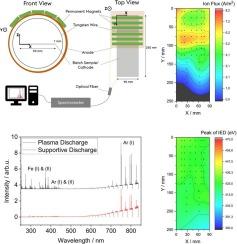钢表面多功能低压等离子体处理装置的特性
IF 6.1
2区 材料科学
Q1 MATERIALS SCIENCE, COATINGS & FILMS
引用次数: 0
摘要
本研究对低压等离子体处理应用于低碳钢表面进行了全面的表征,该低压等离子体处理是在一个简单而通用的等离子体处理装置中进行的。利用光学发射光谱(OES)和延迟场能量分析仪(RFEA)测量来研究等离子体参数和样品表面相互作用。OES证实了样品表面的溅射,而能量和离子通量可以通过改变等离子体发生器的电压和调节由热电子发射器维持的支持等离子体放电来独立调节。该研究测量的电子温度范围从Te = 1 eV到2 eV,离子通量密度高达Ji = 7 A/m2。离子通量密度在样品表面的映射显示了与阳极管的几何形状一致的分布。通过接触角测量和x射线光电子能谱对等离子体处理钢表面进行了研究。结果表明,在能量密度约为EA≈5 J/cm2的短等离子体处理后,表面自由能增加。这可以改善涂层或粘合过程中的附着力,使低压等离子体处理非常适合各种工业应用。此外,有效地减少了钢表面的碳化合物和氧化物,这表明在制造业中需要清洁,活性金属表面以提高性能和寿命的潜在用途。本文章由计算机程序翻译,如有差异,请以英文原文为准。

Characterization of a versatile low-pressure plasma treatment unit for steel surfaces
This study presents a thorough characterization of a low-pressure plasma treatment applied to low-carbon steel surfaces conducted in a simple and versatile plasma treatment unit. Optical emission spectroscopy (OES) and retarding field energy analyzer (RFEA) measurements are utilized to investigate plasma parameters and sample surface interactions. OES confirms sputtering of the sample surface, while the energy and ion flux can be independently tuned by varying the voltage of the plasma generator and adjusting the supportive plasma discharge sustained by a thermionic electron emitter. The study measures electron temperatures ranging from Te = 1 eV to 2 eV and ion flux densities up to Ji = 7 A/m2. Mapping of the ion flux density on the sample surface reveals a distribution consistent with the geometry of the anode tube implemented. Plasma treated steel surfaces are investigated via contact angle measurements and X-ray photoelectron spectroscopy. Results indicate an increase in surface free energy following short plasma treatment at an energy density of approximately EA ≈ 5 J/cm2. This can improve adhesion in coatings or bonding processes, making low-pressure plasma treatment highly suitable for various industrial applications. Additionally, the effective reduction of carbon compounds and oxides on steel surfaces suggests potential uses in manufacturing sectors that require clean, reactive metal surfaces for improved performance and longevity.
求助全文
通过发布文献求助,成功后即可免费获取论文全文。
去求助
来源期刊

Surface & Coatings Technology
工程技术-材料科学:膜
CiteScore
10.00
自引率
11.10%
发文量
921
审稿时长
19 days
期刊介绍:
Surface and Coatings Technology is an international archival journal publishing scientific papers on significant developments in surface and interface engineering to modify and improve the surface properties of materials for protection in demanding contact conditions or aggressive environments, or for enhanced functional performance. Contributions range from original scientific articles concerned with fundamental and applied aspects of research or direct applications of metallic, inorganic, organic and composite coatings, to invited reviews of current technology in specific areas. Papers submitted to this journal are expected to be in line with the following aspects in processes, and properties/performance:
A. Processes: Physical and chemical vapour deposition techniques, thermal and plasma spraying, surface modification by directed energy techniques such as ion, electron and laser beams, thermo-chemical treatment, wet chemical and electrochemical processes such as plating, sol-gel coating, anodization, plasma electrolytic oxidation, etc., but excluding painting.
B. Properties/performance: friction performance, wear resistance (e.g., abrasion, erosion, fretting, etc), corrosion and oxidation resistance, thermal protection, diffusion resistance, hydrophilicity/hydrophobicity, and properties relevant to smart materials behaviour and enhanced multifunctional performance for environmental, energy and medical applications, but excluding device aspects.
 求助内容:
求助内容: 应助结果提醒方式:
应助结果提醒方式:


